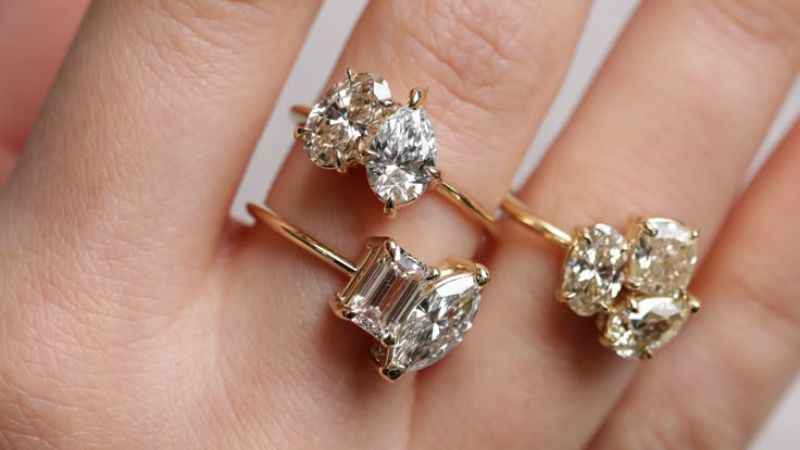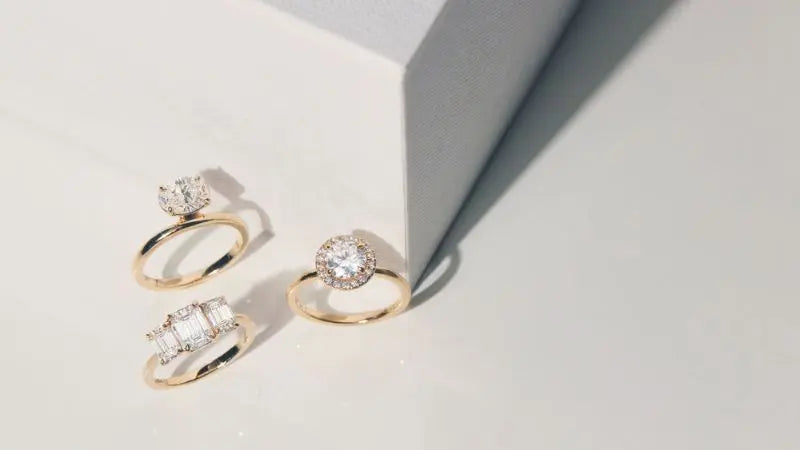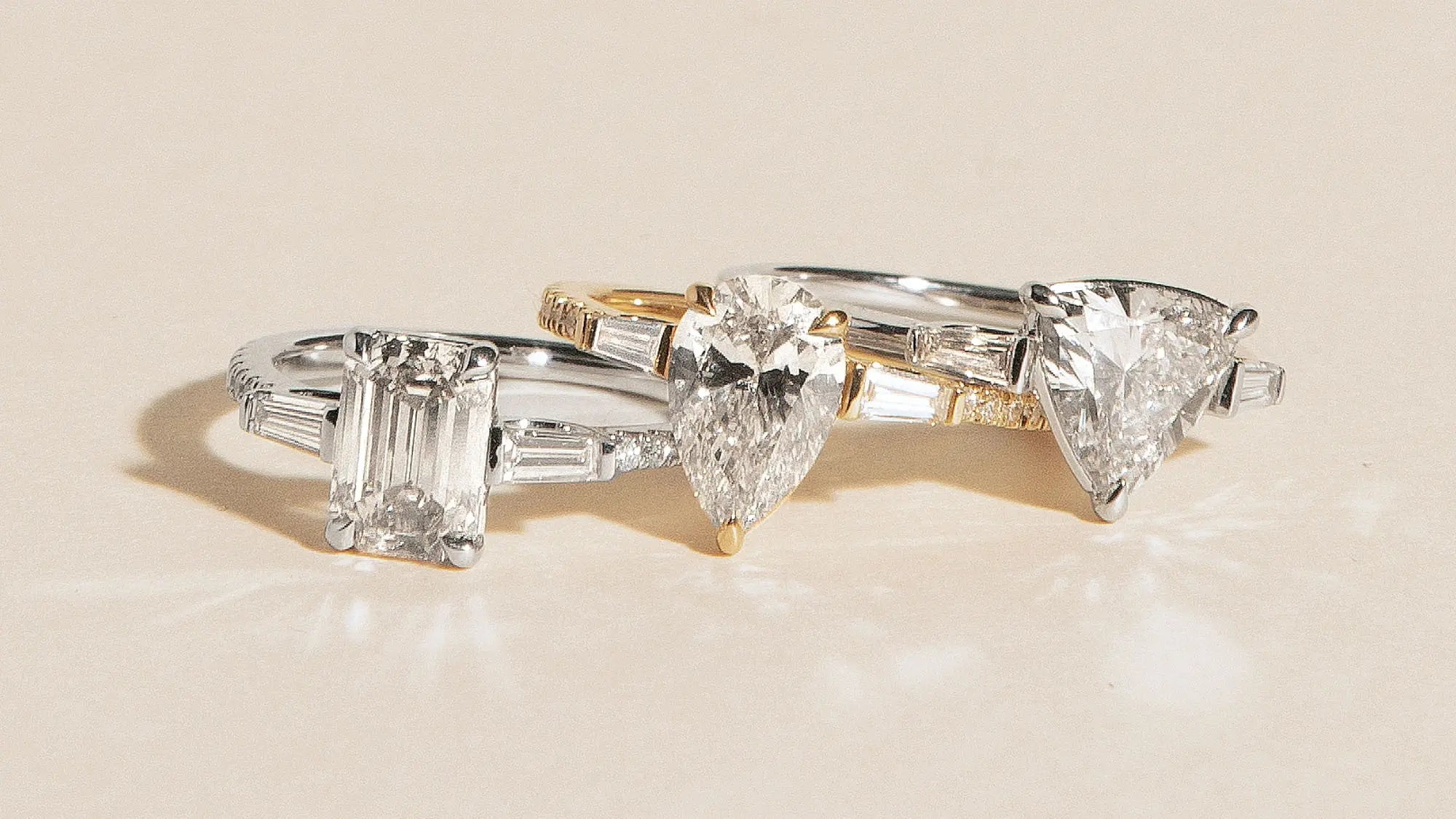Up To $2,500 OFF at checkout - Ends Dec 12
Free 30-day Returns | Lifetime Warranty
In this guide, we will walk you through all there is to know about moissanite vs diamond side by side’s appearance, physical attributes, ethical considerations, and more.
1. Introduction
Two dazzling gemstones - moissanite vs diamond side by side - can you spot the difference? Increasingly popular as an alternative to diamonds, moissanite is now widely used in jewelry, especially as the center stone of engagement rings.
It looks a lot like a diamond - a little more sparkle but otherwise identical - and is nearly as hard. In this guide, we will walk you through all there is to know about moissanite vs. natural diamonds’ appearance, physical attributes, ethical considerations and more.
2. Understanding moissanite and diamonds
2.1. Moissanite
Moissanite was first discovered in a meteor crater in 1893 by Henri Moissan, a Nobel Prize-winning scientist. Composed of silicon carbide that originated in a meteorite, moissanite’s celestial origins and radiant beauty make it a timeless choice for jewelry enthusiasts.

Moissanite stones
The miracle of modern science today has created lab-grown moissanite while preserving its unique sparkle, lowering environmental impact and making it far more affordable than diamonds.
Moissanite is also renowned for its higher refractive index than diamond, which means this gem produces more rainbow ‘fire’ than a diamond when light hits the stone’s surface.
2.2. Diamonds
Natural diamond is a rare gemstone formed deep beneath the Earth’s crust under extreme conditions of heat and pressure over billions of years, unearthed from mines across the globe.
Celebrated as April’s birthstone, it stands as the rarest of all gemstones, especially the most popular choice for engagement ring center stones.

Natural diamonds
In contrast, lab diamonds are produced in a lab from diamond seeds with the same chemical composition as natural diamonds.
Without specialized equipment, it is nearly impossible to tell lab-created diamonds apart from natural ones. The only difference is in the price tag! You will find that lab diamonds are three times less expensive than natural diamonds.

Lab diamond
3. Physical characteristics comparison
3.1. Density and weight
When comparing the carat weight of a moissanite gemstone to a diamond of the same size, the moissanite will weigh less. The weight disparity between moissanite and diamonds stems from their differing densities.
Moissanite, composed of silicon carbide, has a lower density than diamonds made of carbon. As a result, for the same size or diameter, a moissanite stone will weigh less than its diamond counterpart. Due to its lower density, a moissanite also looks visually bigger than a diamond with the same carat size.
3.2. Hardness and toughness
Gemstones are measured using the Mohs scale, which ranks hardness from 1 to 10. Moissanite is rated at 9.25 on the Mohs scale of hardness, making it a highly durable gemstone suitable for everyday wear and able to withstand surface scratching.

Mohs hardness scale
Meanwhile, diamonds are the hardest naturally occurring gemstone known to man, in which they are rated 10 out of 10 on the Mohs scale of hardness. This difference makes diamonds slightly more resistant to scratches and abrasions than moissanite.
3.3. Longevity
While diamonds are harder and more durable, moissanite offers a similar level of resistance to scratches and everyday wear, making it a more affordable alternative to consider. This is why these two gemstones are superior options in the fine jewelry industry.
4. Evaluation of brilliance and fire
4.1. Moissanite brilliance
Moissanite outshines diamonds with its higher refractive index (2.65-2.69), which means it sparkles even more in light. Also, moissanite steals the show with its rainbow-like brilliance.
4.2. Diamond brilliance
Having a lower refractive index (2.42), a diamond provides subtler white flashes or white light returned when it hits the light. Natural diamonds are marginally less brilliant than moissanite and have two times less fire. However, this also depends partly on how the diamond is cut.
4.3. Side-by-side testing
Besides brilliance, fire is a measure of a gemstone's ability to separate white light into spectral colors, resulting in a dazzling, rainbow-like effect. As a lab-created gemstone, moissanite has a higher dispersion rate of 0.104, compared to a natural diamond’s 0.044.

Left: Diamond | Right: Moissanite
Consequently, moissanite tends to display more fire, often causing a noticeable rainbow effect when viewed under light. So, when you look at diamond vs moissanite side by side, moissanite will look like a firework.
5. Color differences: Can you spot the variations?
5.1. Moissanite color
Most moissanite can now be grown as near-colorless varieties dominate, but some can show slight green or yellow undertones under certain lighting.
5.2. Diamond color
is graded on the GIA scale from D to Z, with D-F being colorless and Z displaying noticeable yellow or brown hues.

GIA diamond color grading scale
5.3. Lighting impacts
Moissanite can change color based on lighting and may not always look perfectly colorless. Some stones will appear more yellow or yellow-green. Those sensitive to color may prefer diamond or white sapphire to moissanite.
Meanwhile, with a dispersion rate of 0.044 compared to 0.104 of moissanite, diamonds typically do not produce a noticeable rainbow effect.
6. Hardness and durability
6.1. Moissanite durability
Moissanite, though slightly softer at 9.25 on the Mohs scale, remains a highly durable choice. While it may be more prone to minor wear over time compared to diamonds, both gemstones are strong and well-suited for daily wear.
6.2. Diamond durability
When selecting an engagement ring, durability is crucial, as it will endure daily wear. Diamonds, rated a perfect 10 on the Mohs scale, are exceptionally scratch-resistant and ideal for everyday use.
6.3. Practical insights for wearers
Diamonds, with their unmatched hardness, are ideal for those with active lifestyles or hands-on jobs, as they resist scratches and damage exceptionally well. Moissanite, while slightly softer, remains a durable choice but may show minor wear over time in high-impact settings.
Highlight differences in care routines and maintenance to preserve durability.
7. Alternative gemstone options
7.1. Popular choices beyond diamonds and moissanite
White sapphire
White sapphires have a clear, diamond-like appearance, making them a stunning and sophisticated option for sapphire engagement rings. With excellent durability -ranking just below diamonds on the Mohs scale—they offer lasting quality.

Natural white sapphire
More budget-friendly than diamonds, white sapphires provide the opportunity to choose larger or higher-quality stones without exceeding your budget.
White Topaz
White topaz gemstones serve as great alternatives to diamonds due to their clear, colorless appearance and more budget-friendly price.

Oval-cut white Topaz
Although they’re not as hard as diamonds, ranking 8 on the Mohs scale, white topaz can withstand everyday wear, making them a practical and cost-effective alternative to diamonds for engagement rings.
Emerald
Emeralds are an excellent alternative to diamonds for those looking for a bold and vibrant option. Unlike diamonds, their striking green color sets them apart, making them highly valued for their beauty and historical significance.
With their distinctive elegance, emeralds offer a unique and eye-catching choice over traditional colorless diamonds.

Natural oval-cut green emerald stone
Aquamarine
The tranquil blue hue of aquamarines makes them a stunning choice for engagement rings. More affordable than diamonds, they offer a striking visual appeal at a budget-friendly price.

Oval-cut blue aquamarine
Additionally, aquamarines are durable gemstones ranking 7.5 to 8 on the Mohs scale. This hardness ensures that aquamarine engagement rings can withstand everyday wear.
Morganite
Morganites, with their soft pink hue, offer a romantic and elegant alternative to traditional colorless diamonds.
Slightly less durable but significantly more affordable, morganite engagement rings allow for larger stones without stretching the budget, making them a beautiful and practical choice.

Morganite stone
Ruby
Ruby is a pinkish-red-to-blood-red-colored gemstone. It measures 9 on the Mohs scale, meaning it is tough and durable, yet the chromium can cause cracks and fissures.

Blood-red-colored ruby stone
Rubies are another popular gemstone choice for engagement rings, especially for those who appreciate their deep red tones. They are often associated with passion and love, making them an ideal choice for a romantic gesture.
7.2. Pros and cons of alternative gemstones
Pros:
- Cost-effective: Alternatives like white sapphire and white topaz are generally more affordable than natural diamonds, allowing for larger stones at a lower price.
- Diverse options: These gemstones come in a variety of colors and styles, allowing for more striking designs compared to traditional colorless diamonds.
- Ethical sourcing: Many alternatives are lab-grown or ethically sourced, making them a more sustainable and responsible choice.
Cons:
- Durability: No gemstone matches the hardness of a diamond and a moissanite. While sapphires are relatively durable, diamonds remain the best option for long-lasting wear.
- Brilliance: If maximum sparkle is your priority, no alternative gemstone can fully replicate the fire and brilliance of a diamond, though some come close.
7.3. Why moissanite and diamonds dominate
Moissanite and diamonds dominate the market for fine jewelry, especially engagement rings, due to their exceptional brilliance, durability and overall desirability.

Diamond, moissanite and other gemstones in comparison
Superior brilliance & fire
Diamonds have unmatched brilliance due to their high refractive index and ability to reflect light beautifully. Their sparkle and fire (dispersion of light into colors) are what makes them so sought after.
Moissanite actually surpasses diamonds in fire, displaying more colorful flashes of light, which some people find even more dazzling. Its high refractive index gives it an intense sparkle that rivals diamonds.
Exceptional durability
Diamonds are the hardest naturally occurring substance, ranking 10 on the Mohs scale. This makes them incredibly resistant to scratching and ideal for daily wear.
Moissanite is the second hardest gemstone used in jewelry, ranking 9.25 on the Mohs scale. It is significantly tougher than many other diamond alternatives, ensuring longevity and resistance to scratches.
Market demand & popularity
Diamonds have long been the traditional choice for engagement rings, backed by strong marketing and cultural significance. Their association with luxury and love keeps them in high demand.
Moissanite has gained massive popularity as a diamond alternative, particularly among budget-conscious and ethically minded consumers who still want a high-quality, durable and sparkling gemstone.
8. Ethical and environmental considerations
8.1. Moissanite’s sustainable benefits
Moissanite rings and fine jewelry are ethical for many reasons in comparison to other gemstones. Moissanite is lab-created, ensuring an ethical and eco-friendly option with a low carbon footprint and minimal waste.
As they are made in a lab and not mined from the earth, there are no human rights violations or a huge carbon footprint that will be left behind as there are with diamonds.
8.2. Diamond industry challenges
The diamond industry has long been associated with funding conflict and violence, as the profits from diamond sales often support terrorism and illegal activities.
Additionally, mining for natural diamonds contributes significantly to carbon emissions, negatively impacting the environment.
Furthermore, the industry is known for exploiting workers, including children, who are often underage, overworked and paid very little.
Many workers face dangerous conditions, and the industry frequently violates labor laws, particularly in relation to child labor and unfair wages.
8.3. Lab-grown diamonds: A modern solution
Meanwhile, lab-grown diamonds offer a sustainable and ethical alternative to mined diamonds. Lab-grown diamonds are conflict-free and do not contribute to unethical practices associated with some mined diamonds.
They offer a transparent and ethical alternative for consumers concerned about the diamond industry's social impact.

The 2-carat pave Elisa round lab-diamond ring
8.4. The shift in consumer values
Millennials and Gen Z are reshaping the jewelry market by placing a strong emphasis on sustainability and ethical sourcing when making purchasing decisions.
For these generations, the environmental footprint of jewelry production is a major concern. They prefer brands that use recycled materials, lab-grown gemstones, and ethically sourced metals.
9. Quality and authenticity measures
9.1. Moissanite quality indicators
Before purchasing a moissanite gemstone, request a certificate of authenticity from the jeweler to confirm it has been lab-tested and approved by trained gemologists. This process is also known as moissanite grading.
9.2. Diamond certifications
Diamond certification, usually from the GIA, AGS, IGI, EGL, GSI, and HRD laboratories, is a document you receive from a third-party objective laboratory describing a diamond in all of its characteristics. This is a system used to assess a diamond's quality based on the 4Cs - carat, color, clarity, and cut.
9.3. How to spot differences
The most reliable way to distinguish moissanite from a diamond is by using “a loupe” to examine the jewel from the top, or crown, at an angle.
You will notice two slightly blurred lines - a characteristic known as double refraction, which means that it can split light into two rays as it passes through the crystal. Moissanite’s double refraction creates a “rainbow effect” that is particularly unique in this gemstone.

Diamond’s and moissanite’s refraction under the loupe
Double refraction is easier to see in some shapes than others. For instance, even a highly skilled jeweler using a loupe may struggle to detect double refraction in an emerald cut.
9.4. Tips for buyers
When selecting a gemstone for your engagement ring, don’t hesitate to ask tough questions. A diamond isn’t the only option - some may prefer an alternative that offers beauty without the hefty price tag. So, what should you consider?
- Set a budget: Define your spending limit to focus your search and prevent overspending.
- Do your research: Compare diamonds and moissanite to make an informed choice.
- Prioritize features: Decide what matters most—size, brilliance, ethical sourcing, or durability.
- Know the 4Cs: For diamonds, understand Cut, Color, Clarity, and Carat weight. For moissanite, consider similar factors.
- Buy from trusted jewelers: Choose reputable vendors with certifications, good reviews, and clear return policies.
- Check certifications: Ensure diamonds have grading reports (GIA, AGS) and moissanite comes with authenticity certificates.
- Review return & warranty policies: Confirm the store’s return terms and available warranties.
- Maintenance plan: Learn how to care for your gemstone to maintain its sparkle.
- Consider resale value: Natural diamonds may retain value, while moissanites and lab-grown diamonds typically do not.
10. Moissanite vs diamond in engagement rings
10.1. Appearance in different settings
Moissanite adds brilliance to intricate settings. Diamonds, on the other hand, bring timeless elegance, especially in solitaire or classic settings that highlight their classic beauty.
10.2. Symbolic value
Diamonds are often seen as a symbol of eternal love and tradition. However, moissanite serves as a modern alternative, offering a beautiful and budget-conscious option for those seeking a gemstone with a contemporary appeal.
11. Price comparison
Moissanite is a budget-friendly alternative to diamonds, costing $200–$800 per carat due to its lab-created nature, while diamonds range from $1,500 to over $20,000 per carat based on rarity and quality.
12. Deciding between moissanite and diamond
This price gap allows buyers to afford a larger or higher-quality moissanite for the same budget. While moissanite allows buyers to afford a larger or higher-quality stone within a given budget, diamonds remain the traditional choice with a higher resale value.

Moissanite vs. diamond side by side comparison
13. Frequently asked questions (FAQs)
Question 1: Can you tell the difference between moissanite and diamonds?
It can be challenging to tell the difference between a moissanite and a diamond ring just by looking at it. Moissanite's unique fire and rainbow sparkle may be noticeable, but distinguishing it requires a specialized tool that jewelers have called a loupe, which shows a mark on the girdle. Most people won’t be able to tell the difference with the naked eye.
Question 2: Is moissanite as durable as a diamond?
No, but it is still very durable. Diamonds rank 10 on the Mohs scale, while moissanite is 9.25, making it highly resistant to scratches and suitable for everyday wear.
Question 3: Does moissanite retain its sparkle over time?
Yes, moissanite keeps its brilliance and sparkle for almost a lifetime due to its durability. Its high resistance to scratches makes it a long-lasting choice for jewelry.
Question 4: Are lab-grown diamonds better than moissanite?
It depends on preference. Lab-grown diamonds have the same properties as natural diamonds, offering a more authentic look, while moissanite is more affordable and has more fire (rainbow sparkle).
14. Conclusion
Moissanite rings offer a stunning alternative to traditional diamond rings, combining beauty, durability, and affordability.
Whether you are drawn to its brilliance or eco-friendly nature, a moissanite ring makes a lasting statement. Compare moissanite vs diamond side by side to see how each gemstone shines in its unique way.
With its beauty and affordability, moissanite has become a popular choice for engagement rings and fine jewelry. Whether you are budget-conscious or appreciate its unique qualities, moissanite’s charm is undeniable. Discover the perfect piece from our stunning collection.




